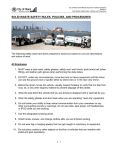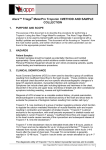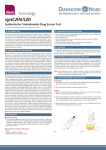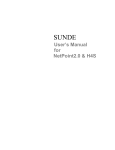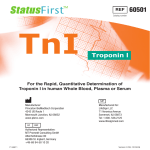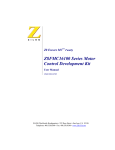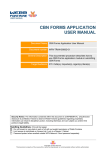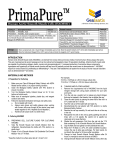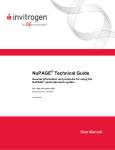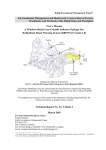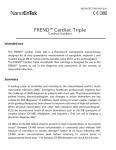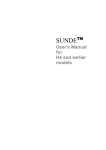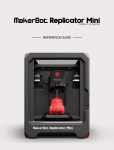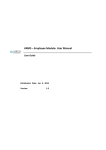Download User Manual - Diagnostik Nord
Transcript
TROP- OPK20 Troponin rapid test with buffer For professional in vitro diagnostic use only. INTENDED USE The Diagnostik Nord Troponin I Test is a rapid one-step chromatographic immunoassay for the qualitative detection of human cardiac Troponin I in whole blood, serum or plasma as an aid in the diagnosis of myocardial infarction (MI). SUMMARY Cardiac Troponin I (cTnl) is a protein found in cardiac muscle with a molecular weight of 22.5 kDa.1 Troponin I is part of a three subunit complex comprising of Troponin T and Troponin C. Along with tropomyosin, this structural complex forms the main component that regulates the calcium sensitive ATPase activity of actomyosin in striated skeletal and cardiac muscle.2 After cardiac injury occurs, cTnI is released into the blood 4-6 hours after the onset of pain. The release pattern of cTnl is similar to CK-MB, but while CK-MB levels return to normal after 72 hours, cTnI levels remain elevated for 6-10 days, thus providing a longer window of detection for cardiac injury. The high specificity of cTnl measurements for the identification of myocardial damage has been demonstrated in conditions such as the perioperative period, after marathon runs, and blunt chest trauma.3 cTnl release has also been documented in cardiac conditions other than acute myocardial infarction /AMI) such as unstable angina, congestive heart failure, and ischemic damage due to coronary artery bypass surgery.4 Because of its high specificity and sensitivity in the myocardial tissue, cTnI has recently become the most preferred biomarker for myocardial infarction.5 The Diagnostik Nord Troponin I Test is a simple test that utilizes a combination of particle conjugated anti-cTnl antibodies and capture reagent to selectively detect cTnl in whole blood, serum or plasma. The minimum detection level is 1.0 ng/mL. PRINCIPLE The Diagnostik Nord Troponin I Test is a qualitative, membrane based immunoassay for the detection of cTnl in whole blood, serum or plasma. The membrane is pre-coated with capture reagent on the test line region of the test. During testing the Troponin I in the whole blood, serum or plasma specimen reacts with two specific anti-cTnl antibodies. One of the antibodies mediates binding to the capture reagent, the other antibody is color labelled. The mixture migrates upward on the membrane by capillary action. In the test line region the cTnI-antibody complex is captured by the immobilised capture reagent so that a red line is generated. The presence of a red line in the test line region indicates a positive result. If the sampled does not contain cTnI no line will form in the test result line region indicating a negative result. In addition a red line must form in the control line region (C) independent of the cTnI concentration in the sample. The control line serves as a procedural control and indicates that sufficient volume of specimen has been added and membrane wicking has occurred. SPECIMEN COLLECTION AND PREPARATION The Diagnostik Nord Troponin I Test can be performed using whole blood (from venipuncture or fingertip), serum or plasma. Whole blood from fingertip: • Wash the hand of the patient with soap and warm water or clean the puncture site thoroughly with alcohol. • Massage the hand in direction of the fingertip of the middle finger or ring finger without touching the puncture. • Prick the fingertip with a sterile lancet. Wipe the first drop of blood. • Rub the hand from the wrist to the palm and to the finger to form a round drop at puncture. Collection of whole blood from fingertip using a capillary: • Take a blood sample filling the capillary with 120 µl of the sample. Avoid air pockets. • Put the dispensary bulb at the top of the capillary and press it to dribble blood sample in the specimen well (S) of the test device. Dispensary of whole blood from fingertip by hanging drops: • Position the finger of the patient exactly above the specimen well (S) of the test device. • Drop 2 hanging drops of whole blood from the puncture of the finger into the specimen well (S). The finger of the patient can be moved over the specimen well so that the drop has contact with the well. A direct contact of the finger and the specimen well should be avoided. • Please note that whole blood is less suitable than serum or plasma since individual coagulation can reduce the flow characteristics of the test. Therefore we recommend to take only 2 drops of whole blood. General comments • Separate serum or plasma from blood as soon as possible to avoid hemolysis. • Heparin blood as well as EDTA or citrate blood plasma can be used but it is recommended to take citrate blood (also for plasma) since EDTA leads to a fast breakdown of the Troponin complex. Heparin is under debate to reduce the amount of Troponin in Plasma as well.7 • You can also directly use anticoagulated blood for the test. • Use only clear, non-hemolyzed specimens. • Testing should be performed immediately after specimen collection. Do not leave the specimens at room temperature for prolonged periods. Serum and plasma specimens may be stored at 2 – 8° C for up to 3 days. For long-term storage, specimens should be kept below -20°C. Whole blood collected by venipuncture should be stored at 2 – 8°C if the test is to be run within 2 days of collection. Do not freeze whole blood specimens. Whole blood collected by fingertip should be tested immediately. • Bring specimens to room temperature prior to testing. Frozen specimens must be completely thawed and mixed well prior to testing. Specimens should not be frozen and thawed repeatedly. • If specimens are to be shipped, they should be packed in compliance with local regulations covering the transportation of etiologic agents. MATERIALS PROVIDED PRECAUTIONS • • • • • • • For professional in vitro diagnostic use only Do not use after expiration date The test should remain in the sealed bag until use Humidity and temperature can adversely affect results Do not use the test if the pouch is damaged The used test should be discarded in accordance with the regulations All specimen might be potentially infectious. Proper handling and disposal methods should be established. Wear protective clothing such as laboratory coats, disposable gloves and eye protection when specimens are being tested. • In a clinical suspicion of a myocardial infarction the test results should only be used as first indication. the patient should be in any case brought to hospital for further investigation. since the blood may contain, even in case of ami, ctni concentrations below the detection limit, a negative result cannot prove the absence of ami. always also other measures must be taken and the result of the test is never to be regarded as a prof alone! • • • • Diagnostik Nord Troponin I Test devices Disposable pipettes (inside pouch) Phosphate buffer Package insert MATERIALS REQUIRED BUT NOT PROVIDED • Tubes for taking blood samples • Centrifuge (for plasma/serum) • Lancets (only for whole blood from fingertip) • Heparinised capillaries and dispensary bulb (only for whole blood from fingertip •Timer TESTING PROCEDURE STORAGE AND STABILITY Store the tests as packaged in the sealed pouch and the buffer in its bottle at room temperature (2-30°C / 36-86 °F). The Diagnostik Nord Troponin I Test is stable until the expiration date printed on the sealed pouch or buffer bottle. The test device must remain in the sealed pouch until use. • Do not freeze. • Do not use beyond the expiration date. 1 Allow the Diagnostik Nord Troponin I Test device, specimen, and/or controls to equilibrate to room temperature (15 – 30 °C/59 – 86 °F) prior to testing. 2 Remove the test device from the sealed pouch and use it as soon as possible. Best results will be obtained if the assay is performed within one hour. Place the Diagnostik Nord Troponin I Test device on a clean and level surface. T S T S T CTnl C CTnl C S T C S CTnl T C T T S C S S T S CTnl C S S T C T CTnl S LITERATURE CTnl C T C T CTnl C CTnl S CTnl C S T C CTnl S C T S C T S T S CTnl CTnl S S S CTnl T T T S CTnl T C 1. Adams, et al. Biochemical markers of myocardial injury, Immunoassay Circulation 88: 750-763 (1993). 2. Mehegan JP, Tobacman LS, Cooperative interaction between troponin molecules bound to the cardiac thin filament. 3. J. Biol. Chem. 266:966 (1991) 4. Adams, et al. Diagnosis of Perioperative myocardial infarction with measurements of cardiac troponin I. N.Eng.J. Med 330:670 (1994). 5. Hossein-Nia M, et al. Cardiac troponin / release in heart transplantation. Ann.Thorac. Surg. 61 : 227 (1996). 6. Joint European Society of Cardiology/American College of Cardiology: J.Am. Coll. Cardio., 36(3), „Myocardnial Infarction Redefined, 2000. 7. Stiegler et al 2000. Lower Cardiac troponin T and I results in heparin-plasma than in serum. Clinical chemistry sep 46(9) : 1338-44 C S C C C T CTnl C SYMBOLS QUALITY CONTROL As internal procedural control the Diagnostik Nord Troponin I Test includes the control line. It is only formed if sufficient specimen volume has been added and the chromatography has been finished successfully. Control standards are not supplied with this kit; yet, we recommend that positive and negative controls should be tested as a good laboratory practice to confirm the test procedure and to verify proper test performance. LIMITATIONS 1. The cTnI Rapid Test Device (Whole Blood/Serum/Plasma) is for professional in vitro diagnostic use, and should only be used for the qualitative detection of cardiac Troponin I. No meaning should be inferred from the color intensity or width of any apparent lines. 2. The cTnI Rapid Test Device (Whole Blood/Serum/Plasma) will only indicate the presence of Troponin I in the specimen and should not be used as the sole criteria for the diagnosis of myocardial infarction. 3. If the test result is negative and clinical symptoms persist, additional testing using other clinical methods is recommended. The minimum detection limit of the assay is 1.0 ng/mL of cTnI in specimens. Thus, a negative result does not at anytime rule out the existence of Troponin I in blood, because the protein concentration may be below the minimum detection level of the test. Please keep in mind that the rise of Troponin I takes place several hours after the onset of pain. If the testing takes place too early, cTnI concentrations might still be too low to be detected by the assay. A negative test result does not exclude the possibility of myocardial infarction at any time. 4. Like with all diagnostic tests, a confirmed diagnosis should only be made by a physician after all clinical and laboratory findings have been evaluated. Content n CTnl CTnl S CTnl T C CTnl C CTnl T The control line (C) is not formed. In this case the result is invalid even if the test result is visible. Insufficient specimen volume or incorrect procedural techniques are the most likely reasons for control line failure. Review the test procedure and repeat the assay with a new test device. If the problem persists, discontinue using the test kit immediately and contact you local distributor. S T C S S T CTnl C S CTnl INVALID T S T C CTnl T C S CTnl Two red lines appear. One line forms in the control line region (C) and another line forms in the test line region (T). NOTE: The intensity of the red color in the test line region (T) will vary depending on the concentration of cTnl present in the specimen. Therefore, also faint reddish test result lines (T) should be considered positive. C CTnl CTnl S T CTnl C S T CTnl C S T CTnl C One red line appears in the control line region (C). No apparent red line appears in the test line region (T). Confirm negatiuve results after 15-20 min NOTE: In some cases, the sensitivity of the assay can increase up to 15 min but at the same time the probability increases that blood from the sample stains the result window red. POSITIVE CTnl S T C CTnl INTERPRETATION OF RESULTS T T Start the timer. Wait for the red line(s) to appear. The result should be read at 10 minutes. Do not interpret the result later than 20 minutes after sample addition (false-positive results possible). NEGATIV C (holds for 3a – 3c) CTnl C S CTnl T C +1 4 S T C S CTnl T T CTnl C S CTnl T CTnl C C S T C CTnl T CTnl C C S Fingertip Whole Blood: Transfer 2-(3) hanging drops of whole blood from the fingertip puncture / or approximately 120 µl whole blood from the heparinised capillary into the round specimen well (S) of Diagnostik Nord Troponin I Test. Add 1 drop of buffer and start the clock. 3 S CTnl T S Analytical sensitivity The minimum detection limit of the assay is 1.0 ng cTnI/ml. For the regular control of the minimum detection limits, standard materials of Hytest are used (free cTnI). Please note that due to the heterogeneity of commercially available standard materials the sensitivity of the assay might vary slightly with different standard preparations. Analytical Specificity Sera containing known amounts of cTnl antigen have been tested with 10,000 ng/ml Skeletal Troponin I, 2,000 ng/ml Troponin T, and 20,000 ng/ml Cardiac Myosin. No cross-reactivity was observed, indicating that Diagnostik Nord Troponin I Test has a high degree of specificity for cardiac Troponin I (cTnI). Cross-Reactivity The Diagnostik Nord Troponin I Test has been tested and no interference was observed in specimens containing 110 µg/ml human albumin, 6 mg/ml bilirubin, 1 mg/ml haemoglobin, 100 µg/ml cholesterol and 10 mg/ml triglycerides. Inter-lot variation Three independent batches were tested with different samples spiked with different concentrations of fresh and negative samples. There were no differences observed between the results of the different batches. All results obtained were as expected. Compatibility with other devices The performance of the Diagnostik Nord Troponin I Test has been compared with a commercially available test accredited for the sale in the EU of another manufacturer. The results of the study de-monstrated an overall accuracy of >99 % for the tested specimens. Specimen without cTnI consistently yielded negative results with both test. Specimen with cTnI-concentrations above the detection limit showed positive results with both assays. C CTnl S CTnl C S T C T CTnl CTnl TEST PERFORMANCE S T C S 5. Some specimens containing unusually high titers of heterophile antibodies or rheumatoid factor (RF) may affect expected results. Even if the test results are positive, further clinical evaluation should be considered with other clinical information available to the physician. 6. In rare cases it is possible that the antigen-antibody reaction of the test is inhibited by the presence of auto-antibodies in the patient’s blood, which block the binding sites. False negative test results might be the consequence. Please note that this is a general problem with all detection methods based on an antigen-antibody reaction for the detection of proteins. C S CTnl CTnl S C S T CTnl C B T CTnl Venipuncture Whole Blood (with/without citrate etc) : Hold the provided pipette vertically and transfer 3 drops of whole blood into the round specimen well (S) of the Diagnostik Nord Troponin I Test. Add 1 drop of buffer and start the clock. or: 3 T A C Serum or plasma or venipuncture blood: Hold the provided pipette vertically and transfer 3 drops of serum or plasma (ca. 120 µl) into the round specimen well (S) of the Diagnostik Nord Troponin I Test. Start the clock. or: 3 For in-vitro diagnostic use only Lot number For single use only Expiry date Carefully read package insert 30 °C 2 °C Keep dry Store at room temperature catalogue number Rev.: 02.06.2015 (JM) replaced 09.12.2014 (JM) PRODUCER Diagnostik Nord GmbH Mecklenburgstraße 97 19053 Schwerin Germany Telefon: Fax: E-Mail: Internet: +49 (0)385/208409-0 +49 (0)385/208409-29 [email protected] www.diagnostik-nord.de



